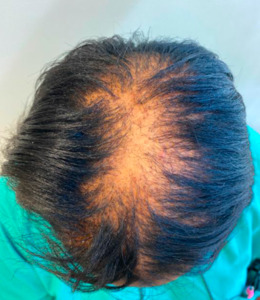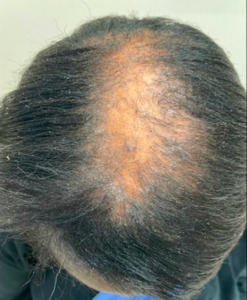Case Presentation
A 53-year-old African American female presents to the dermatology clinic for diffuse, patchy hair loss associated with pruritus and flaking of the scalp for the past sixteen years, rapidly worsening over the last year. There has been no hair loss in the pubic and axillary regions. The patient mentions using coconut oil and aloe on the scalp and receives a chemical hair treatment every three months. The patient has a history of seborrheic dermatitis, folliculitis of the face, hypertension, and hypercholesterolemia. It was also noted that the patient has a family history of systemic lupus erythematosus.
On physical exam, there are non-scarring alopecic patches with significant scaling of the scalp (Figure 1). Labs including a complete blood count, basic metabolic panel, and thyroid studies are unremarkable.
Treatment is initiated with clobetasol ointment, ketoconazole shampoo, and collagen/biotin supplements which provide minimal improvement. Ultimately, the patient’s regimen includes clobetasol ointment, triamcinolone ointment, oral minoxidil, ketoconazole shampoo, and intralesional corticosteroid injections (performed six times). On this regimen, the patient notices moderate improvement with many areas of hair growth (Figure 2).
Discussion
Given the centrifugal pattern of this patient’s hair loss and history of using certain hairstyling techniques, it was determined that this patient’s presentation can be attributed to two types of alopecia: central centrifugal cicatricial alopecia (CCCA) and traction alopecia. CCCA is a scarring alopecia characterized by permanent hair loss manifesting in the center of the scalp, progressively spreading outward; it is predominantly diagnosed in women of African descent. While the cause of CCCA is unclear, but presumed to be a multifactorial etiology, it does commonly present with signs of inflammation and premature desquamation of the inner root sheath on histopathology. Treatment focuses on early encouragement of hair regrowth and preventing progression of hair loss, given that hair will not regrow from permanently damaged hair follicles. First-line therapy includes topical corticosteroids, intralesional corticosteroid injections, and sometimes oral tetracyclines given their anti-inflammatory properties.1
Traction alopecia is a type of hair loss caused by hairstyling techniques, such as those used by this patient, and it is often seen in the African American population. It is characterized by sudden-onset or gradual, patchy areas of hair loss of the occipital, frontal or temporal hairline associated with crusting or tenderness. Management of traction alopecia is to first provide recommendations on low-risk hairstyles and reducing the amount of chemicals and heat applied to the hair. Medical therapies including intralesional corticosteroids, minoxidil, and oral/topical antibiotics can be considered when inflammation is present. If the areas of hair loss are associated with fibrosis, hair transplant can be considered.2
Management of hair loss focuses on halting or slowing progression with the hopes of providing some hair regrowth. With the current therapies available, there is merely partial effectivity in most cases. Further research and pharmacological advances in this area could provide a significant impact on quality of life for these patients.




